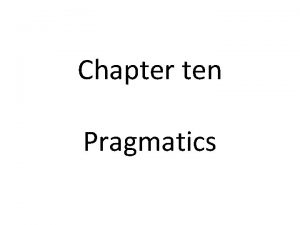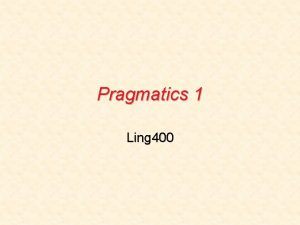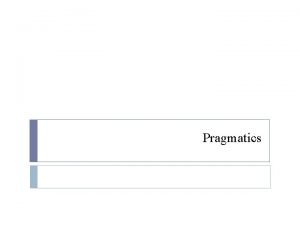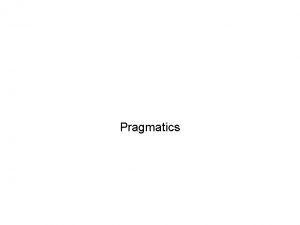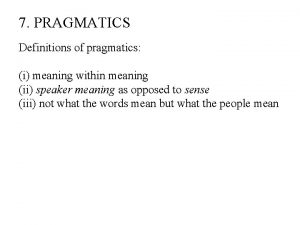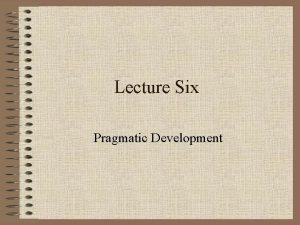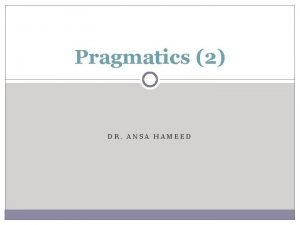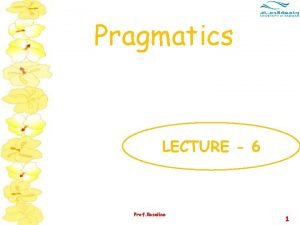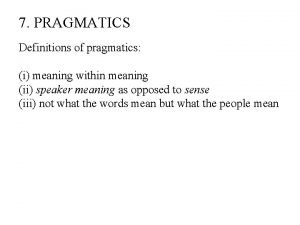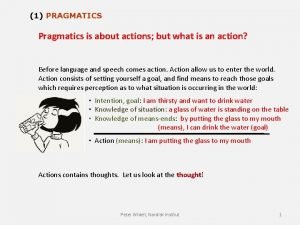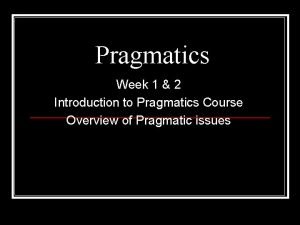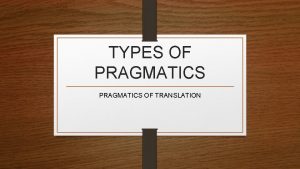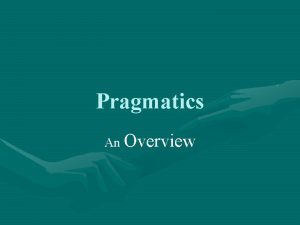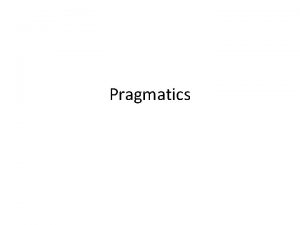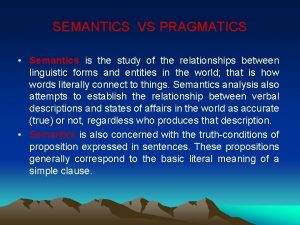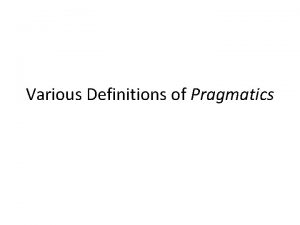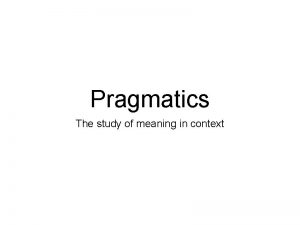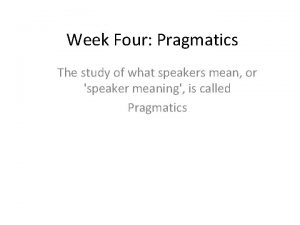Pragmatics is the study of how people do




























- Slides: 28

Pragmatics is the study of how people do things with words.

Pragmatics studies the factors that govern people’s choice of language in social interaction and the effects of this choice on others.

Pragmatics and Semantics: Pragmatics asks: “What do you mean by “……”? ” Semantics asks: “What does “……” mean? ”

Pragmatics and Semantics: Meaning in pragmatics is defined as relative to the speaker (or user) of the language. Meaning in semantics is defined as a property of expressions of a given language, in abstraction from particular situations, speakers or hearers.

In the uses of language what is meant is often more than , or different from, what has actually been said.

Presuppositions • Presuppositional information adds facts/beliefs to what is explicitly said • Presuppositional information is that which is taken for granted My wife will go to London tomorrow (the speaker has a wife) My number is 212 -555 -1212 (the speaker has a telephone account) I’m upset about being charged for a call to Ethiopia (the speaker was charged for a call to Ethiopia) I’m a bachelor (the speaker is an unmarried male person) • Test: the negation and question presuppose the same thing Diane’s children are nice. Diane’s children aren’t nice. Are Diane’s children nice? Diane has got some children

RULES OF CONVERSATION • The use of language is governed by social rules, a set of conventions shared by the language users. • These conventions change and evolve naturally. • Children are not explicitly told these conventions, but acquire them by trial and error, like many other social conventions.

Paul Grice: Theory of Conversational Implicature How is it possible to mean more than we actually say?

PAUL GRICE • Grice’s aim was to understand how “speaker’s meaning” rises from “sentence meaning” ( Speaker meaning = Sentence meaning + What is implicated) • Grice proposed that many aspects of “speaker’s meaning” result from the assumption that the participants in a conversation are cooperating in an attempt to reach mutual goals – or at least are pretending to do so! • Conversation is a cooperative behaviour, and therefore proceeds by rules of cooperative conduct. • Grice called this the Cooperative Principle.

The Cooperative Principle. “Make your conversational contribution such as is required, at the stage at which it occurs, by the accepted purpose or direction of the talk exchange in which you are engaged”

The cooperative principle has four sub-parts, four rules or maxims that people involved in conversations tend to respect: 1. The maxim of quality 2. The maxim of quantity 3. The maxim of relevance 4. The maxim of manner

(1)The maxim of quality (“Tell the truth”) Do not say what you believe to be false. Do not say that for which you lack adequate evidence.

(2) The maxim of quantity (“Say just as much as is necessary”) Make your contribution as informative as is required for the current purposes of the exchange. Do not make the contribution more informative than is required.

. (3) The maxim of relation / relevance (“Stick to the point”) Make your contributions relevant.

(4) The maxim of manner (“Be clear”) Avoid obscurity. Avoid ambiguity. Be brief. Be orderly.

Grice was not acting as a prescriptivist when he stated these maxims. He observed the difference between “what is said” and “what is meant” to show that people actually do follow these maxims in conversation.

An example on the maxim of quantity: Mum: Did you finish your homework? Pat: I finished my algebra. Mum: Well, get busy and finish your English, too! The child did not say that her English homework is not done, nor did she imply it. Nevertheless her mother is entitled to draw this conclusion, based on the combination of what the child actually said and the cooperative principle.

An example on the maxim of relation/relevance: The maxim of relevance is behind the implications of this letter of recommendation (a classic type of example). Dear Colleague, Dr John Jones has asked me to write a letter on his behalf. Let me say that Dr Jones is unfailingly polite, is neatly dressed at all times, and is always on time for his classes. Yours sincerely, Prof. H. P. Smith The person reading this letter assumes that all the relevant information will be included; so the maxims of quantity and relevance lead one to suspect that this is the best that the professor can say.

Maxims may be: Observed Ex: John got into Columbia and won a scholarship. I went to the supermarket and I bought some sugar. “and” means that both linked events occurred, but implicates also temporal progression due to the maxim of manner: be orderly.

Maxims may be: Violated (because of a clash with another maxim) A: Where does Dave live? B: Somewhere in the South of France This response infringes the first maxim of quantity, but does so in order to avoid violating the second maxim of quality. What is the implicature?

Maxims may be: Flouted E. g. : A: Will you come out on a dinner date with me? B: Hasn’t the weather been lovely recently? B flouts the maxims of quantity and relevance. What is the implicature?

The linguistic meaning of what is said + The information from the context (shared knowledge) + The assumption that the people speaking are observing the cooperative principle = Conversational implicature Implicature interpretation requires both Speaker and Hearer to be collaborative Ex: A. I got an A on that exam. B. And I’m Queen Marie of Rumania. A. Where did you go? B. Out. A: Where does Arnold live? B: Somewhere in southern California.

Jokes are a good example and often rely on the hearer’s knowledge of the rules of conversation for their humorous effect. In the following joke, the woman is also violating the maxim of relevance: I came home last night, and there’s a car in the dining room. I said to my wife: “How did you get the car in the dining room? ” She said: “It was easy. I made a left turn when I came out of the kitchen. ”

Types of implicatures Implicature conventional conversational generalized particularized

Conventional implicatures • not based on cooperative principle or maxims • encoded in the lexicon or grammar • not dependent on context for their interpretations Ex: George is short but brave. (contrast) Sue and Bill are divorced (conjunction) He jumped on his horse and rode away. (sequence) I dropped the camera and it broke (consequence)

Coversational implicatures • Inferred via the cooperative principle or maxims (observed, violated or flouted) Ex: A: I am out of petrol. B: There is a garage around the corner.

Generalized conversational implicatures • independent of the context Ex. : 1. Indefinites A car ran over John’s foot. (not John’s car / not the speaker’s car) the speaker is assumed to follow the maxim of quantity, if he wanted to be more specific he would have said my car or John’s car 2. Scalar implicatures communicated by choosing a word expressing a value from a scale (quantity, frequency, etc. ) 3. I’m studying linguistics and I’ve completed some of 4. the required courses (not all) 5. If the scale is all, most, many, some, few. . , the use of some implicates that all the higher items in the scale are to be considered negative.

Particularized conversational implicatures • dependent on a specific context Ex. : Rick: Hey, coming to the party tonight? Tom: My parents are visiting. (flouting relevance) Ann: Where are you going with the dog? Sam: To the V. E. T. (flouting manner) Bert: Do you like ice-cream? Ernie: Is the Pope Catholic? (flouting relevance)
 Hình ảnh bộ gõ cơ thể búng tay
Hình ảnh bộ gõ cơ thể búng tay Bổ thể
Bổ thể Tỉ lệ cơ thể trẻ em
Tỉ lệ cơ thể trẻ em Gấu đi như thế nào
Gấu đi như thế nào Glasgow thang điểm
Glasgow thang điểm Hát lên người ơi alleluia
Hát lên người ơi alleluia Môn thể thao bắt đầu bằng chữ f
Môn thể thao bắt đầu bằng chữ f Thế nào là hệ số cao nhất
Thế nào là hệ số cao nhất Các châu lục và đại dương trên thế giới
Các châu lục và đại dương trên thế giới Công thức tính độ biến thiên đông lượng
Công thức tính độ biến thiên đông lượng Trời xanh đây là của chúng ta thể thơ
Trời xanh đây là của chúng ta thể thơ Cách giải mật thư tọa độ
Cách giải mật thư tọa độ Làm thế nào để 102-1=99
Làm thế nào để 102-1=99 Phản ứng thế ankan
Phản ứng thế ankan Các châu lục và đại dương trên thế giới
Các châu lục và đại dương trên thế giới Thể thơ truyền thống
Thể thơ truyền thống Quá trình desamine hóa có thể tạo ra
Quá trình desamine hóa có thể tạo ra Một số thể thơ truyền thống
Một số thể thơ truyền thống Cái miệng nó xinh thế chỉ nói điều hay thôi
Cái miệng nó xinh thế chỉ nói điều hay thôi Vẽ hình chiếu vuông góc của vật thể sau
Vẽ hình chiếu vuông góc của vật thể sau Nguyên nhân của sự mỏi cơ sinh 8
Nguyên nhân của sự mỏi cơ sinh 8 đặc điểm cơ thể của người tối cổ
đặc điểm cơ thể của người tối cổ V. c c
V. c c Vẽ hình chiếu đứng bằng cạnh của vật thể
Vẽ hình chiếu đứng bằng cạnh của vật thể Vẽ hình chiếu vuông góc của vật thể sau
Vẽ hình chiếu vuông góc của vật thể sau Thẻ vin
Thẻ vin đại từ thay thế
đại từ thay thế điện thế nghỉ
điện thế nghỉ




























